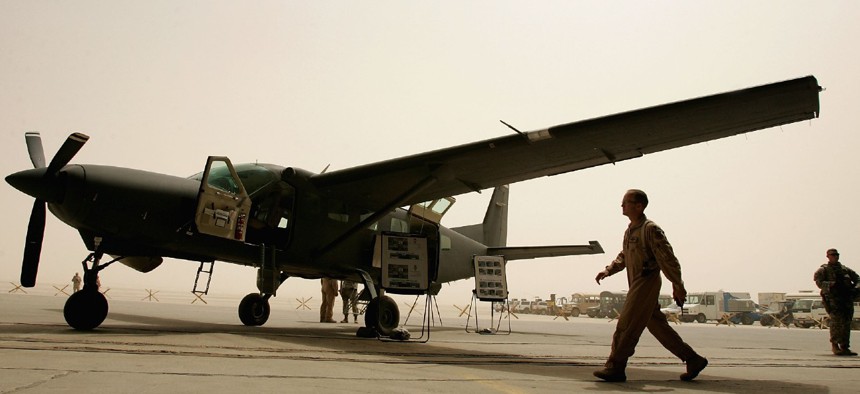
Iraqi air force members and their U.S trainers are seen near the Iraqi air force Caravan (Cessna 280) Intelligence, Surveillance and Reconnaissance (ISR) aircraft on July 30, 2008 at the New Al Muthana Air Base in Baghdad, Iraq. Wathiq Khuzaie /Getty Images
New Plane Key to Special Ops Vision for Africa, General Says
Air Force Special Operations Command is planning flight demonstrations in coming months.
A new aircraft that can fly reconnaissance missions and bomb enemy forces is key to U.S. special forces’ future in Africa, the head of Air Force Special Operations Command said Tuesday.
Lt. Gen. James Slife spoke as the Biden administration reviews the U.S. military’s global footprint and prepares to advise Congress on reorienting American forces for future conflicts.
“I would suggest to you that if we want to maintain pressure on those violent extremist organizations that pose a threat to the United States — that pose a threat to the homeland — we may need to remain engaged in portions of Africa against very specific threats and not just broadly, anywhere where there's an extremist, but specifically where those that pose an external threat are,” Slife said Tuesday during a Mitchell Institute for Aerospace Studies Zoom event.
Called Armed Overwatch, the new planes are the Air Force’s latest attempt to field counterinsurgency aircraft that are cheaper to fly than high-performance fighter jets. But lawmakers aren’t sold on the project; they’ve cut millions of dollars that would have allowed the Air Force to start buying planes this year.
“Ultimately, I believe that SOCOM will be able to demonstrate to the Congress that this is a viable program, and it's required for the future operating environment,” Slife said.
U.S. Special Operations Command plans to conduct flight demonstrations of “a handful of aircraft” in the coming months. The results of those trials will determine the path ahead, but the general said he hopes to “be in a procurement” of a commercial aircraft that doesn’t require a lengthy development in fiscal 2022.
“I think we can do that at relatively low risk based on what we've seen from the vendors who have indicated that they intend to bring platforms to demonstrate for us in the coming months,” he said.
The new armed plane is envisioned to replace an aging fleet of unarmed U-28 reconnaissance planes. U.S. Special Operations command is planning to hold a demonstration of commercially available planes that could be used for the missions “in the coming months,” Slife said.
“We need to get through this demo to see what industry can produce at low risk in a short order,” he said.
Air Force Special Operations Command flies unarmed U-28s, militarized Pilatus PC-12s, and MC-12Ws, militarized Beechcraft King Air 350s for intelligence, surveillance and reconnaissance missions. It also flies armed MQ-9 Reaper drones. Special ops leaders are planning to retire the U-28 when the new Armed Overwatch aircraft arrives.
For years, the Air Force has considered buying a fleet of propeller-driven light-attack planes, but never moved past the demonstration phase. The latest effort is different, Slife said.
“This is not a rehash of the Air Force light-attack program,” he said. “SOCOM envisions this as more of a multi-role platform that can perform level delivery of precision munitions.”
The general said the planes are not likely to have ejection seats, like those included in more expensive attack aircraft.
“If we're trying to fly airplanes that require ejection seats, we're probably focused on the wrong thing as the Air Force component of SOCOM,” Slife said.
His comments would seem to exclude the Sierra Nevada/Embraer Super Tucano, Beechcraft AT-6B, Textron/AirLand Scorpion and Leidos/Paramount Bronco II, which are all considered light-attack planes and all have ejection seats. That could leave planes like the Air Tractor AT-802U or Cessna AC-208 Armed Caravan as options. The Iraqi Air Force flies single-engine Cessna Caravans armed with Hellfire missiles.
During the wars in Afghanistan and Iraq, fighters, bombers, electronic attack aircraft, intelligence planes and refueling tankers would fly over a target in a “stack” over one another between 10,000 and 25,000 feet. This “is not viable for the future [and] it's not cost-effective” for combating violent extremist organizations, Slife said.
“We need to collapse the stack...into a smaller number of platforms,” he said.
That means a plane that can gather intelligence and strike enemy targets on the ground.
“It's really a multirole airplane that's capable of operating with a very light logistics footprint in small disaggregated teams...in very austere regions,” Slife said.
NEXT STORY: Biden: ‘I Will Never Politicize’ US Troops







